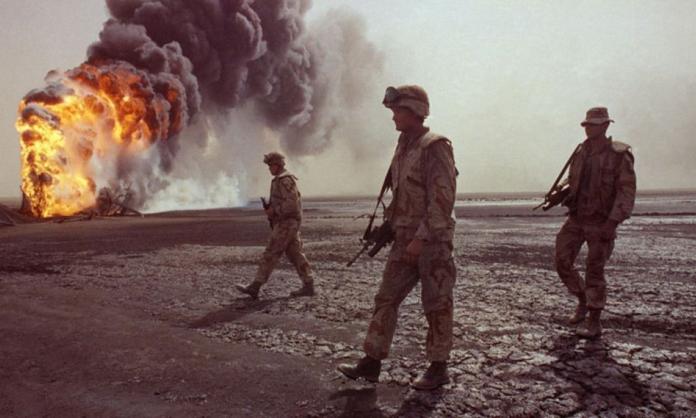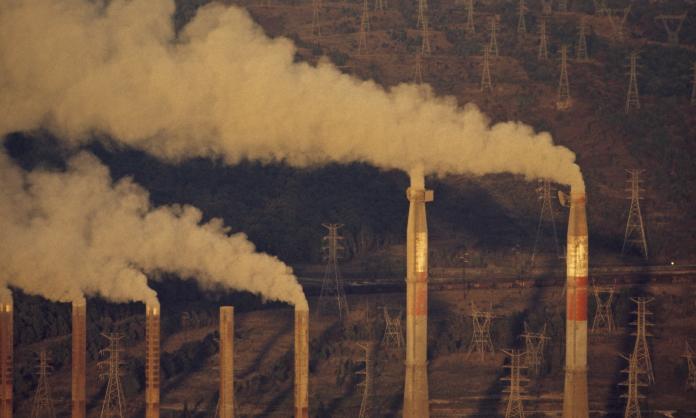The scale of death and destruction that could be unleashed by the world’s military forces today goes well beyond what happened in the most catastrophic wars of the twentieth century. And the damage caused by militarism isn’t limited to the direct human toll of wars. As well as having the potential to destroy human lives on an unprecedented scale, today’s militarism is highly destructive to the environment.
While just over a century ago cavalry (soldiers who fought on horseback) was still a mainstay of warfare, today horses have been replaced by heavily fortified trucks and mechanised tanks. “Falcon” fighter jets and B-52 bombers, with the power to annihilate entire cities from above, have replaced the flimsy wooden biplanes of World War I. Today the arms industry is among the world’s biggest, with global military spending totalling US$1,981 billion in 2020.
Military production depends on the consumption of large quantities of fossil fuels and involves countless other environmentally destructive processes. The mining, refining and production of some of the key resources employed in military production, like aluminium, steel and nickel, are highly energy intensive, producing massive emissions of carbon dioxide and other greenhouse gases.
Over half the energy required for aluminium smelting is currently produced by burning coal, and the perfluorocarbons released during the smelting process are between 6,500 and 9,200 times more potent as drivers of global warming than carbon dioxide. Nickel mining emits millions of tonnes of toxic sulphur dioxide per year, and has a history of severe pollution of the land, air and water surrounding mines—such as when a major spill from the Norilsk nickel factory in Russia turned the Daldykan river bright red in 2016.
Steel production contributes 3.3 billion tonnes annually to global carbon emissions. The iron and steel industries are estimated by the International Energy Agency to be responsible for around 6.7 percent of the world’s total carbon dioxide emissions.
Then there are nuclear weapons. Even if we discount the possibility that the thousands of nuclear warheads currently armed and ready to deploy around the world will one day lead to the destruction of all human civilisation, we must factor in the poisonous industry that produces them. Whatever the industry’s backers might say, the risks involved in mining uranium, producing power in nuclear reactors and dealing with radioactive waste are all too obvious from the history of highly destructive accidents—from the Ranger uranium mine spill in 2013, to the catastrophic meltdowns at Chernobyl and Fukushima.
The US military is both the world’s single largest consumer of fossil fuels and its largest producer of carbon emissions. The five largest US chemical companies combined produce only a fifth of the military’s emissions.
Multiple studies show a correlation between states’ increased military spending and high emissions. Armies internationally are also responsible for two-thirds of global emissions of chlorofluorocarbons—a volatile derivative of methane that, in addition to contributing to global warming, destroys the ozone layer that protects Earth from damaging ultraviolet light (a major cause of skin cancer). These substances were banned under the 1987 Montreal Protocol, but the military use of them goes on.
And all this concerns only the day to day “peacetime” operations of the military. War itself, as well as killing, maiming and destroying human lives, is catastrophic for the environment, flattening landscapes and poisoning the air.
Environmental destruction can be a conscious tool of warfare. During the Vietnam War, the US sprayed an estimated 20 million gallons of the chemical defoliant Agent Orange across the country in order to clear forest canopies providing cover to North Vietnamese and Viet Cong troops and to cripple agriculture. The toxic effects of Agent Orange on Vietnam’s environment, farming and human life continue to today.
Even when not purposefully destroying nature, warfare causes irreparable environmental damage. The US bombing campaigns in Iraq in the 1990s and 2000s created extensive pollution and environmental degradation. The use of ammunition tipped with depleted uranium contaminated possibly tens of thousands of hectares of Iraqi land and led to elevated levels of birth defects in communities where the bombing was most intense.
And the initial destruction wrought by wars has massive roll-on effects. After the 1991 Gulf War and 2003 US invasion, cases of typhoid increased tenfold among the Iraqi population as a result of water pollution due to the destruction of sewage systems and other basic infrastructure.
Similar damage occurred in Afghanistan. Already in 2003, just two years into a war that has now dragged on for two decades, a United Nations Environment Programme report found that the war, combined with a lengthy drought, had “caused serious and widespread land and resource degradation, including lowered water tables, desiccation of wetlands, deforestation and widespread loss of vegetative cover, erosion, and loss of wildlife populations”.
As the world continues to warm, and the destructive impacts of climate change become more immediately apparent, the drive to militarisation is only intensifying. The key factor in the new global arms race is the rising tensions between the United States and China. Here in Australia, these tensions explain the Morrison government’s 2020 pledge to spend $270 billion over the next decade on “new and upgraded defence capabilities”.
However, the Australian military—among others—has also factored in the so-called “security risks” associated with climate change (such as conflict over resources, greater numbers of refugees and social instability) in their decision to boost military capacity. The 2016 Defence White Paper highlighted the Australian military’s role in responding to instability in the region and stated that “climate change means we will be called on to do so more often”.
This focus of governments diverts badly needed research away from solving the climate crisis towards further contributing to it. At least 32 Australian universities are currently participants in the Defence Science Partnerships Program, linking up with the Australian Defence Force and various arms manufacturers like Lockheed Martin and BAE Systems in order to develop new military technologies. Brainpower that could be directed towards creative solutions to climate change is compelled by the capitalist system to invent instruments of death instead.
Fighting for the planet means resisting the competitive imperatives of capitalism, which flings the system into war repeatedly and compels states to devote resources towards defending their position on the imperial ladder in ever more brutal ways. The drive to militarisation doesn’t just threaten millions of lives. It threatens the future of our planet, too.
Protest the Brisbane Weapons Expo, 7:00am, 1 June, outside the Brisbane Convention Centre. Follow Shut Down Land Forces Expo on Facebook and Instagram to find out more.










